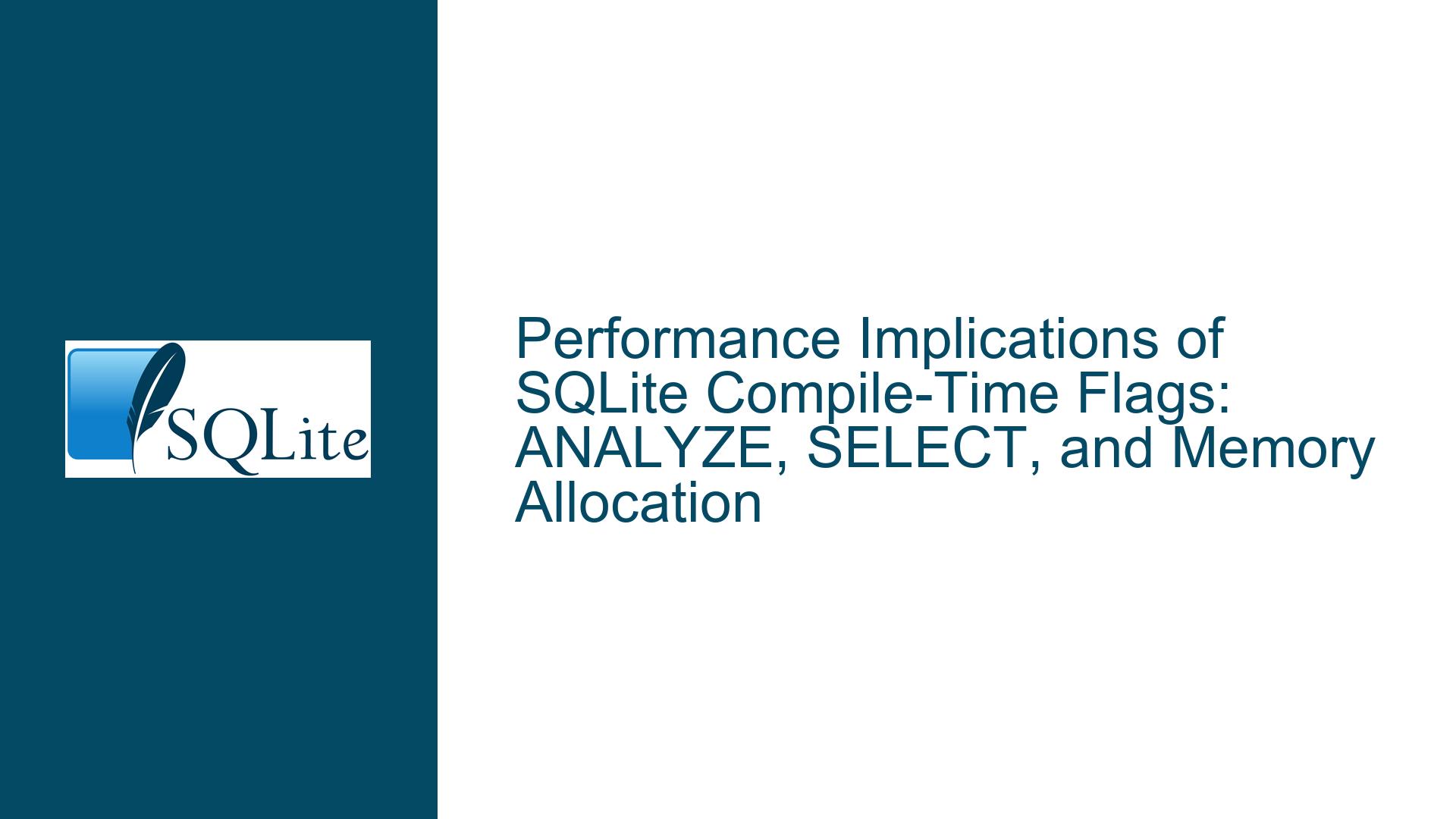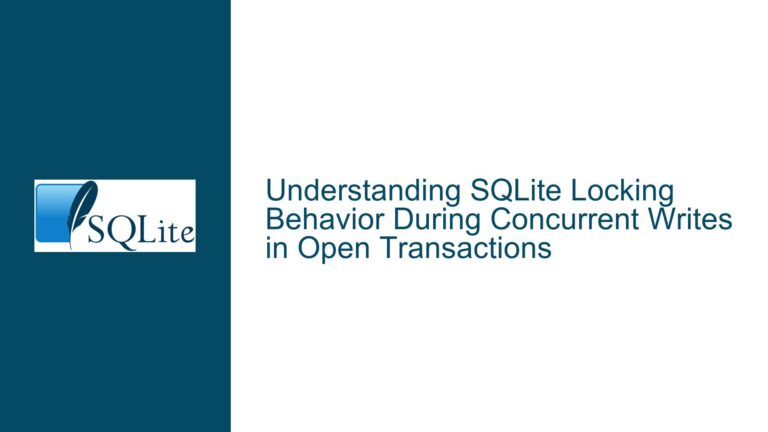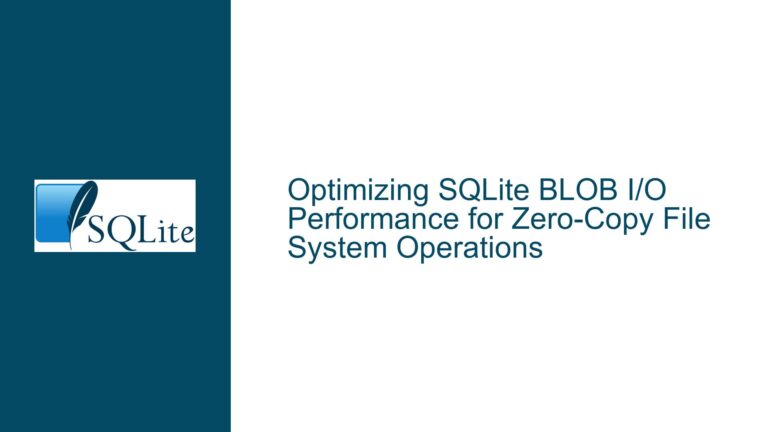Performance Implications of SQLite Compile-Time Flags: ANALYZE, SELECT, and Memory Allocation
Understanding the Impact of SQLITE_ENABLE_DBSTAT_VTAB and SQLITE_ENABLE_STAT4 on Performance
Issue Overview
The core issue revolves around the performance implications of enabling specific compile-time flags in SQLite, namely SQLITE_ENABLE_DBSTAT_VTAB and SQLITE_ENABLE_STAT4. These flags are designed to enhance the functionality of SQLite by enabling additional features, but they come with potential trade-offs in terms of performance, database size, and query execution latency. The primary concerns are:
- ANALYZE Latency: The time it takes for the
ANALYZEcommand to execute, which is crucial for gathering statistics that the query planner uses to optimize queries. - Database Size: The impact on the physical size of the database file, which can affect storage requirements and potentially I/O performance.
- SELECT Statement Latency: The time it takes for
SELECTqueries to execute, which is directly related to the efficiency of the query planner and the underlying data structures.
Additionally, the discussion touches on the SQLITE_DEFAULT_MEMSTATUS flag, which controls whether SQLite tracks memory usage. This flag has a significant impact on multi-threaded performance due to its use of a mutex to serialize memory allocations.
Possible Causes
SQLITE_ENABLE_DBSTAT_VTAB: This flag enables the
dbstatvirtual table, which provides detailed information about the database file’s structure. While this feature is useful for debugging and optimization, it increases the size of the SQLite executable. However, if thedbstatvirtual table is not used, it should not impact performance. The primary concern here is the potential increase in the binary size, which could affect startup times and memory usage, especially in embedded systems with limited resources.SQLITE_ENABLE_STAT4: This flag enables the collection of more detailed statistics during the
ANALYZEcommand, specifically for index data distribution. While this can lead to better query plans and improvedSELECTperformance, it also increases the time required to runANALYZE. Additionally, queries that depend on parameter values may need to be re-prepared after parameter binding, which can degrade performance if the same statement is executed multiple times.SQLITE_DEFAULT_MEMSTATUS: This flag controls whether SQLite tracks memory usage. When enabled, it wraps memory allocators in a mutex to ensure thread safety, which can lead to contention in multi-threaded environments. Disabling this flag removes the mutex, allowing for more concurrent memory allocations but at the cost of losing memory tracking capabilities. This can significantly impact performance in multi-threaded applications, as demonstrated by the benchmark results showing up to a 4x difference in execution time with increasing thread counts.
Troubleshooting Steps, Solutions & Fixes
Evaluating the Need for SQLITE_ENABLE_DBSTAT_VTAB: Before enabling this flag, consider whether the
dbstatvirtual table is necessary for your use case. If you do not require detailed insights into the database file’s structure, it is best to leave this flag disabled to avoid unnecessary increases in the executable size. If you do need this feature, ensure that your system has sufficient resources to handle the larger binary size without impacting performance.Assessing the Impact of SQLITE_ENABLE_STAT4: If you decide to enable
SQLITE_ENABLE_STAT4, be prepared for longerANALYZEexecution times. This is a trade-off for potentially better query plans and improvedSELECTperformance. To mitigate the impact, consider runningANALYZEduring off-peak hours or when the database is less busy. Additionally, monitor the performance of queries that depend on parameter values, as they may require re-preparation after parameter binding. If you notice performance degradation, consider disabling this flag or optimizing your queries to reduce the need for re-preparation.Optimizing SQLITE_DEFAULT_MEMSTATUS for Multi-Threaded Environments: If your application is multi-threaded and performance is a concern, consider disabling
SQLITE_DEFAULT_MEMSTATUS. This will remove the mutex around memory allocators, allowing for more concurrent memory allocations and potentially improving performance. However, be aware that this will disable memory tracking, which may make it more difficult to diagnose memory-related issues. If you choose to disable this flag, ensure that your application is thoroughly tested to identify and address any memory leaks or other issues that may arise.Benchmarking and Profiling: To make informed decisions about which compile-time flags to enable, conduct thorough benchmarking and profiling of your application. Measure the impact of each flag on
ANALYZElatency, database size, andSELECTstatement latency under realistic workloads. Use tools likesqlite3_profileandsqlite3_traceto gather detailed performance data and identify bottlenecks. This will help you determine the optimal configuration for your specific use case.Considering Alternative Optimization Strategies: While compile-time flags can have a significant impact on performance, they are not the only way to optimize SQLite. Consider other strategies such as optimizing your database schema, indexing, and queries. For example, ensure that your tables are properly normalized, create indexes on frequently queried columns, and use prepared statements to reduce the overhead of query parsing and planning. Additionally, consider using tools like
EXPLAIN QUERY PLANto analyze and optimize your queries.Monitoring and Continuous Improvement: Performance optimization is an ongoing process. Continuously monitor the performance of your SQLite database and make adjustments as needed. Keep an eye on metrics such as query execution time, memory usage, and database size. Regularly review and update your compile-time flags, schema design, and queries to ensure that your database remains performant as your application evolves.
In conclusion, the performance implications of enabling SQLite compile-time flags such as SQLITE_ENABLE_DBSTAT_VTAB, SQLITE_ENABLE_STAT4, and SQLITE_DEFAULT_MEMSTATUS are complex and depend on your specific use case. By carefully evaluating the need for each flag, conducting thorough benchmarking, and considering alternative optimization strategies, you can make informed decisions that balance functionality and performance. Remember that performance optimization is an ongoing process, and continuous monitoring and improvement are key to maintaining a high-performing SQLite database.






